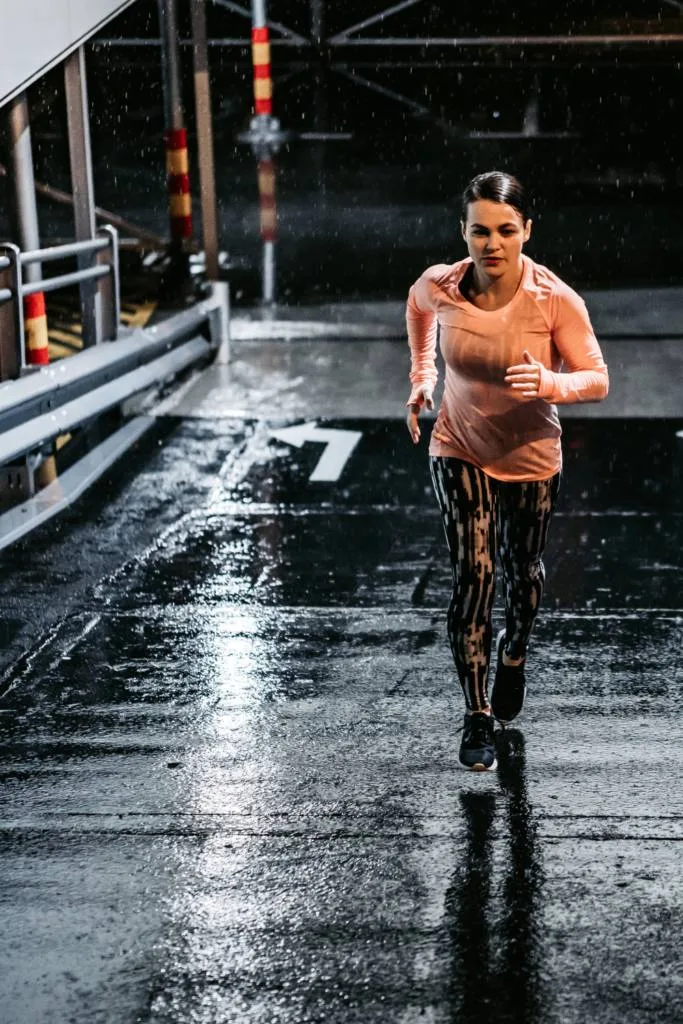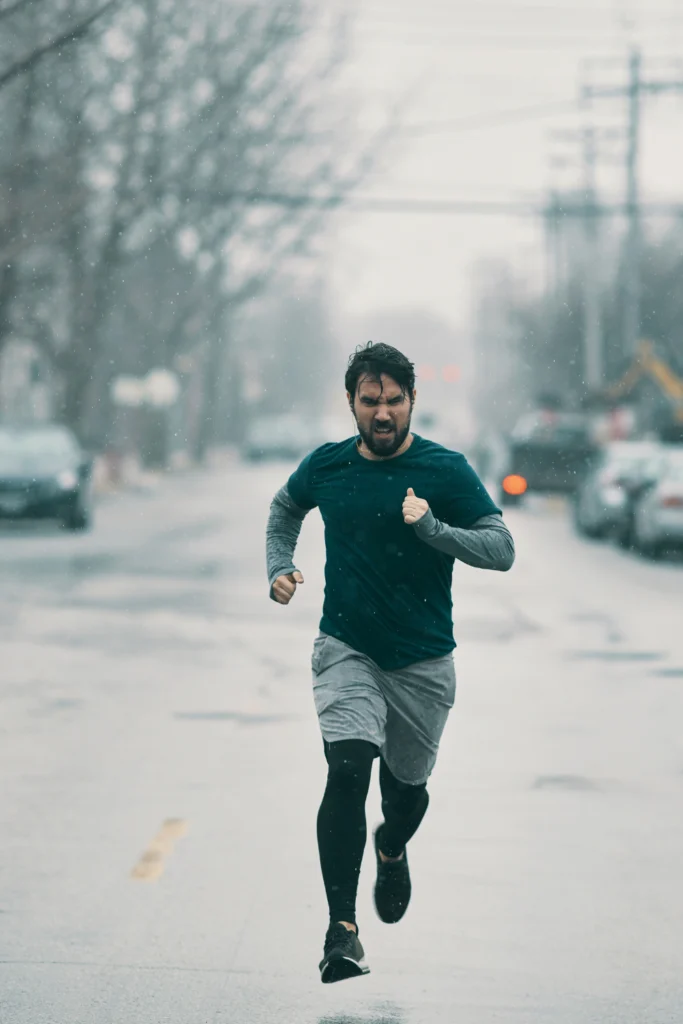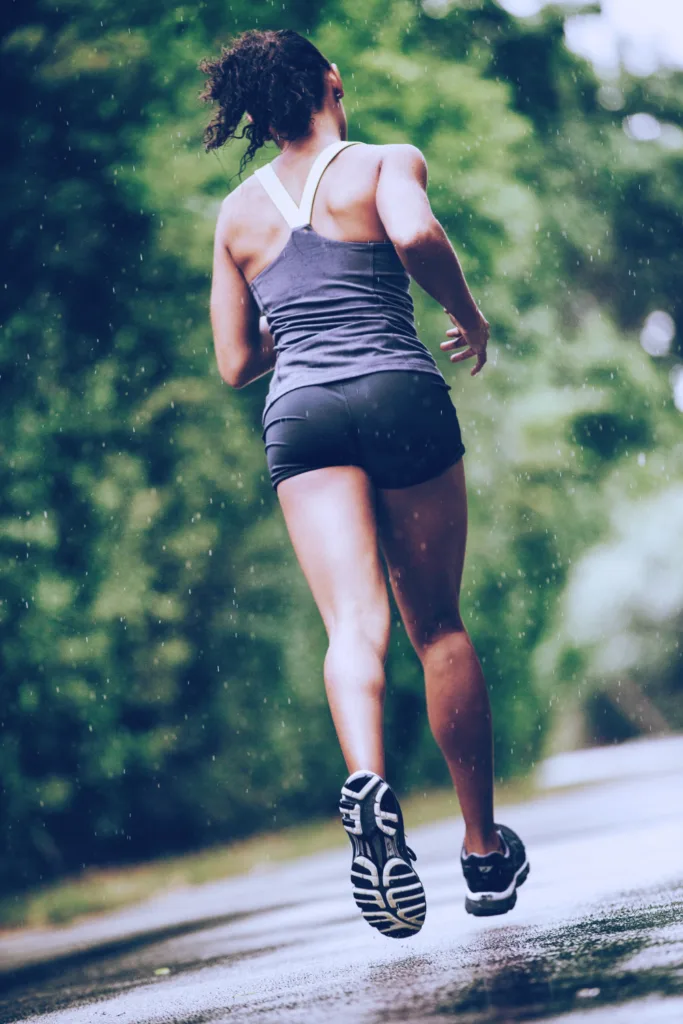Whether you detest running in the rain, or find it quite refreshing, running in the rain is an altogether different experience.
If you’re training for a long distance event, you may have no chance but to run in the rain, especially if you live in a country with unpredictable weather.
Whilst running in the rain may not be ideal, it doesn’t have to ruin your workout.
By embracing the elements and following the tips in this guide, you will soon be able to enjoy your run in the rain and make it a success.
In this guide we’ll look at:
- Benefits of running in the rain
- Is it safe to run in the rain?
- What to wear running in the rain
- What are the best shoes for running in the rain?
- 10 tips for running in the rain
Ready?
Let’s go!

Benefits of running in the rain
Running in the rain – you either love it or you hate it – but there are actually benefits to running in the rain.
Here are four key benefits of running in the rain:
#1 Keeps you cool
When you run in the heat and humidity, your body has to work that much harder to keep your body cool.
Running in the rain can bring down your core temperature quickly which can make running in hot temperatures less strenuous and help to improve performance.
#2 Helps to build physical and mental toughness
Running in the rain means you can tick one more weather condition off the bucket list when it comes to training in all weathers.
Adverse conditions like rain challenge your body and mind and help to build physical and mental toughness.
The bottom line? You will become a more resilient runner by running in the rain.
You’ll also be safe in the knowledge that if it rains on race day, you’ll be prepared.
#3 Adds variety into your training routine
Whether or not you enjoy running in the rain, it can add variety into your training routine.
Rainy weather means a different sort of run. Splashing through puddles makes you feel like a kid again!
#4 Allows you to test your wet weather gear
We all know the benefits of owning a water resistant jacket, but when do you actually get to use it when on a run?
Running in the rain calls for a new set of running gear, so this is your opportunity to have a bit of retail therapy and purchase some new exciting gear for your next run.
Related: 7 tips for safely running in the heat and humidity
Is it safe to run in the rain?
Generally speaking it’s safe to run in the rain, unless you’re in the middle of a thunderstorm or a heavy downpour, then it’s wise to hold off running until the weather clears.
Roads and pathways can become slippery when wet.
If you’re out on the trails, watch your footing when you run as paths can quickly give way.
If in doubt, check the weather forecast before you go for a run.
Related: How to dress for winter running

What to wear running in the rain
As with any run, it pays to be prepared. Here is my running in the rain checklist:
- A couple of base layers (such as a long-sleeved shirt under a T-shirt)
- A water resistant jacket (such as a light rain jacket)
- Compression leggings or shorts (compression leggings will help to keep your legs warm)
- Running socks (and a spare dry pair)
- Waterproof running shoes (ideally with good traction)
- A hat with a brim (to shield your face from the rain)
Materials that are light and moisture-wicking such as polypropylene are best for running in the rain. These help running in rainy weather easier by controlling your body temperature.
Stay away from cotton because it tends to absorb water.
When it comes to running shoes and running jackets, Gore-Tex is a great material for rainy weather.
Gore-Tex is a waterproof, breathable fabric membrane which makes it perfect for outdoors activities like running and hiking.
It has microporous properties that repel water from the outside but let it breathe on the inside to avoid condensation and improve breathability.
Related: 7 of the best websites to buy affordable running gear
What are the best shoes for running in the rain?
Despite what some people may say, running shoes cannot be 100% waterproof, even with a Gore-Tex membrane.
A good pair of water resistant running shoes will go some way to keep the water out, but running shoes cannot completely prevent moisture from entering.
The same lining that helps to keep the water out will also slow the draining process, meaning moisture from your foot when it sweats will take longer to leave the shoe.
Socks are also good at absorbing water and sweat so the moisture from your socks will also enter your shoe.
When it comes to investing in a pair of water resistant running shoes, look for shoes with a Gore-Tex lining. This lining will help to keep your feet drier for longer.
Your choice of running shoe will also depend on the terrain in which you’ll be running on.
Whether you’ll be running on roads or trails, make sure you invest in a pair of suitable running shoes as you would do on a normal, dry weather run.
It’s worth noting that there is a lot more choice when it comes to water resistant trail running shoes as opposed to water resistant road running shoes.
Related: How to find the right running shoes: A complete guide
5 of the best water resistant road running shoes
Here are the best water resistant road running shoes according to Sole Review.
- Brooks Ghost 14 GTX
- Asics GT-2000 10 GTX
- Asics Cumulus 23 GTX
- Asics Pulse 13 GTX
- Adidas Solarglide 4 Gore-Tex
5 of the best water resistant trail running shoes
Here are the best water resistant trail running shoes according to Sole Review.
- Adidas Terrex Agravic TR Gore-Tex
- Brooks Cascadia 16 GTX
- Hoka Challenger Low GTX
- Nike Pegasus Trail 3 Gore-Tex
- Saucony Peregrine 12 Gore-Tex

10 tips for running in the rain
Now you know everything about running in the rain, here are some tips to make your next run in the rain a success.
#1 Embrace the rainy weather
The best way to run in the rain is just to embrace it and enjoy it.
Accept that you’re going to get wet from the get go and this will make your run a whole lot easier.
#2 Dress for rainy weather
As the old saying goes, there’s no such thing as a bad run but how you prepare for it.
While it’s tempting to wear a waterproof jacket and multiple layers, you risk overheating as soon as you start to warm up a bit on your run.
Waterproof jackets also have a tendency to trap moisture, so invest in a water resistant jacket with breathable layers instead.
Avoid cotton where possible as this tends to absorb moisture, and instead opt for moisture-wicking and breathable fabrics.
#3 Wear the right running shoes
Opt for running shoes with good traction to reduce the risk of slipping.
Running shoes with deeper grooves on the soles will help you navigate your rainy run safely.
Water resistant running shoes with a Gore-Tex lining will also help to keep the water out, but as discussed earlier, no running shoe is truly waterproof.
#4 Re-assess your running route
Roads, pathways and trails can become slippery and unsteady when wet, so re-assess your running route, especially if you think there is a risk of flash flooding or unsteady terrain.
Road running or treadmill running is a great alternative if trail running is not an option for you during rainy weather.
#5 Be visible
Running in the rain often means poor visibility, so opt for outer layers that have bright and high visibility fabrics.
Running gear with reflective strips, for example, are a good choice when running in the rain.
#6 Prevent chafing
Running in rainy weather can mean you’re more susceptible to chafing as your running gear gets wet and rubs against your skin.
Use products like Vaseline and Bodyglide to help prevent chafing and blisters.
#7 Carry a pair of dry running socks
A pair of dry running socks will do wonders for your run, as there is nothing worse than running in a pair of soggy socks.
Carry a spare pair of dry running socks so you can change into them mid-run or when your socks start to become wet.
A dry pair of socks will also help to prevent chafing and blisters.
If you’re running a race, you may also want to keep a spare change of dry clothes for when you finish the race.
#8 Dry your shoes
When you finish your run, dry your running shoes by stuffing newspaper into them. The paper will help draw moisture away from the shoes.
You may be tempted to shove your shoes into a drying cupboard or in front of a heater, but this will only serve to shrink your shoes so they won’t fit you properly.
#9 Change out of your wet running clothes
Change out of your wet running clothes as soon as you get home from your run.
Staying in your wet clothes will lower your core body temperature, so it’s wise to change into warm, dry clothes as soon as you can.
#10 Protect your electronics and valuables
There’s nothing worse than a water-logged phone.
Make sure you protect your valuables such as your phone and headphones on your run by putting them in a waterproof carrier or zip lock bag.
You may also want to check whether your running watch is in fact waterproof.
- 5 things I wish I’d known before returning to running - March 3, 2024
- Running 20 minutes a day: Benefits + how to start - January 27, 2024
- How to run your first 2 hour half marathon - January 16, 2024
